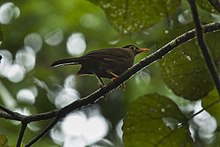Sulawesi thrush
| Sulawesi thrush | |
|---|---|

| |
| Scientific classification | |
| Domain: | Eukaryota |
| Kingdom: | Animalia |
| Phylum: | Chordata |
| Class: | Aves |
| Order: | Passeriformes |
| Family: | Turdidae |
| Genus: | Cataponera Hartert, 1896 |
| Species: | C. turdoides
|
| Binomial name | |
| Cataponera turdoides Hartert, 1896
| |
The Sulawesi thrush (Cataponera turdoides) is a species of passerine bird, monotypic within the genus Cataponera in the thrush family, Turdidae.[2] It is endemic to the island of Sulawesi in Indonesia, where it inhabits evergreen montane forests at altitudes of 1,100–2,400 m (3,600–7,900 ft). Although it has a limited range and is not a common bird, the IUCN has assessed it as being a "least-concern species".
Description
The Sulawesi thrush is a medium-sized species with a long beak, short rounded wings and robust legs. The head and upper parts are a dark olive brown and the underparts are somewhat paler, sometimes with a gingery or reddish tinge to the under-tail coverts. There is a distinctive black supercilium above the eye.[3][4]
Distribution
The Sulawesi thrush is endemic to the island of Sulawesi in Indonesia.[1] Its habitat is evergreen montane forest and moss-forest and its altitudinal range lies between 1,100 and 2,400 m (3,600 and 7,900 ft). Four subspecies are recognised; C. t. abditiva from the northern part of the island; C. t. tenebrosa from the southern part; C. t. turdoides from southwestern Sulawesi and C. t. heinrichi from the southeast. It is not present in the central part of the island.[3]
Ecology
The Sulawesi thrush is a shy bird that is seldom seen and has been little studied.[4] The diet consists of fruits and invertebrates[3] and it forages in the middle and lower storeys of the canopy in evergreen montane forests, and on the ground beneath the trees. In behaviour and appearance it resembles thrushes in the genus Turdus, but it has other behaviours which are similar to those of the Old World babblers (Timaliidae), and the laughing thrushes (Garrulax).[4]
Status
The Sulawesi thrush has a somewhat restricted range and is a generally uncommon bird. The population is thought to be declining slowly but not at such a rate as to make it vulnerable, and the International Union for Conservation of Nature has assessed its conservation status as being of "least concern".[1]
References
- ^ a b c BirdLife International (2012). "Cataponera turdoides". IUCN Red List of Threatened Species. 2012. Retrieved 7 August 2016.
{{cite journal}}: Invalid|ref=harv(help) - ^ Gill, Frank; Donsker, David, eds. (2016). "Thrushes". World Bird List Version 6.2. International Ornithologists' Union. Retrieved 8 July 2016.
- ^ a b c Collar, N. "Sulawesi Thrush (Cataponera turdoides)". In del Hoyo, J.; Elliott, A.; Sargatal, J.; Christie, D.A.; de Juana, E. (eds.). Handbook of the Birds of the World Alive. Lynx Edicions. Retrieved 8 July 2016.(subscription required)
- ^ a b c Clement, Peter; Hathway, Ren (2010). Thrushes. Bloomsbury Publishing. p. 34. ISBN 978-1-4081-3542-6.

